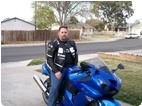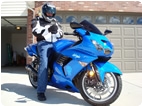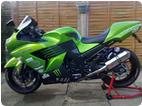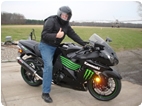ZX14MAN64, Hi, good questions!
First; work = energy. The two are interchangeable as work is done by energy and energy can be stored by doing work. They are interchangeable.
Efficiency comes into play when one is comparing work or energy input to a transducer (power train, etc) of some sort with the work or energy output from the same. 100% efficiency is impossible; losses must occur even in an ideal system. It is only assumed in relating the theoretical relationship between phenomena in mathematical expressions. See the Carnot cycle in thermodynamics.
The descriptive mathematics relating the principles of physical laws do not consider efficiency in their definitions and do not involve a "middle man" driven mechanism of some sort between input and output.
On the dyno at the tire contact patch the Torque measured and the Hp produced are intended to be taken at the surface of the rear wheel. If those numbers were compared to measures of Torque and Hp at the crank, then we could calculate the efficiency of the drive train (chain, gears, tire elastomers, etc.) No efficiency calculation can be made for measures taken at the same point in the the chain; efficiency is either meaningless here or 100% by default depending on how you want to look at it.
Now, Torque will rise with the increase in force on the piston due to the increase in fuel burnt in the cylinder and as the RPM rises the increased charging effect caused by the increase in velocity of air flow into the stacks (as one example) will cause a continuation of increase in the fuel being burnt and repeat. So, yes this can be termed a synergistic effect. This is only one example of both Torque and RPM varying together. We could consider other factors such as the valve timing and the degree of complete combustion possible over a variable fraction of the piston transit cycle, etc. Of course, all these variables have physical limits and are limited by the demands of other systems of the engine operation simultaneously. These consideration will determine the efficiency of the engine as a whole; "how much of the chemical energy in the A/F charge, is converted (transduced) to kinetic energy at the crank?"
Drive line losses include heating of the moving parts, internal strain/shear of the material of the chain, gear, wheel and tire materials, friction losses laterally in the bearings and mounts, even the kinetic energy of the gasses in the tire as they "heat up" and the pressure rises.
Efficiency=Eff = work output/work input (*100% if you want the coefficient in %). If the time period of work output and work input is the same (no energy storage devices located between input and output)then Eff = Power output/ Power input
(*100%). Example: Power at crank is measured to be 93 hp and power at the tire patch is measured to be 86 hp. Then
Eff = Power out/ Power in * 100% = (86 hp/93hp)*100% = .9247 *100% = 92.47% The drive line total efficiency from input at crank to output at the tire patch in contact with the road or the rollers on a dyno is 92.47% Now the torque ratios and rpm ratios as individual values will be quite different from the efficiency ratio between the crank and the tire patch; the drive line is a transducer after all and the operable gear ratios and final gear diameter to tire diameter ratios will determine the trade off between torque and RPM; but their product at both points (input and output) will have the same output to input ratio and efficiency.
So what is lost in the drive line to reduce the power out from power in? If there is no slippage of gears or tire on rim or tread on road surface/rollers, then torque has been lost internally in stretching the chain, flexing and releasing the materials making up the chain and gears, shearing of rubber, etc.
In general, direct drives or chain driven gears or high tensile strength/ elastic modulus belts and pulley systems are more efficient than fluid transmissions where a working fluid must be moved under pressure to transmit power from input to output. Heavy driveshafts and couplings require power to drive their mass as they transmit power from input to output and tend to be less efficient for that reason.
In summary:
Efficiency is always the ratio of work output to work input or if invariant time parameters apply, it is also the ratio of power output to power input. Torque values and RPM values may vary inversely as the power is transmitted/transformed through a mechanism of some sort. Only their product should remain the same from input to output unless loss of energy occurs and efficiency is less than the ideal 100%. Energy storage devices like a freely rotating flywheel or a capacitor in an electrical circuit or a water tower in a water supply system, will allow the delivery (output) of energy over a shorter or longer time period than the time period over which it was produced and stored (input). In these cases
the efficiency of the system is only calculable as total work or energy output over total work or energy input and NOT as Power out over Power in.
Hope this did not put you to sleep.










